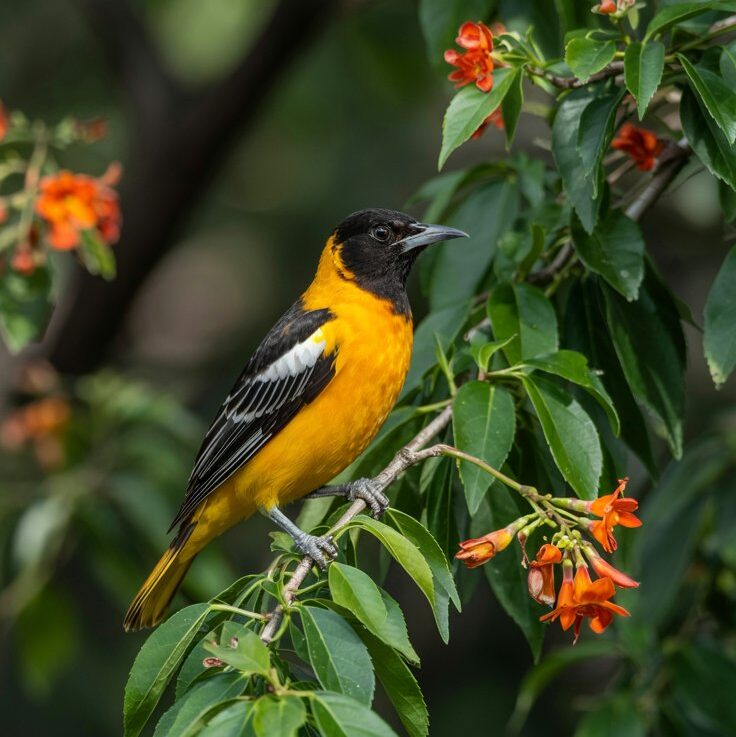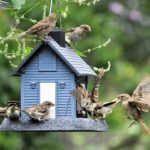Looking to attract those beautiful orange and black visitors to your yard this spring? Orioles love sweet treats, and making your own oriole nectar at home is both easy and economical.
Homemade oriole nectar is simple to make with just sugar and water in a 1:4 ratio, providing the perfect energy source these colorful birds need after their long migration.
While hummingbirds get most of the nectar attention, orioles actually enjoy a slightly different recipe. These larger birds prefer their nectar a bit less concentrated than hummingbirds do. You’ll also want to serve it differently – orioles have bigger bills and can’t use typical hummingbird feeders. Try using special oriole feeders or even halved oranges skewered onto a spike for an easy DIY option.
Did you know that besides nectar, orioles are particularly fond of oranges? Adding some fruit to your feeding station creates an irresistible buffet for these bright visitors. Place your nectar and fruit offerings in open areas where orioles can easily spot them as they fly by, and you’ll be enjoying these stunning birds all season long.
The Sweet Spot: Crafting Homemade Oriole Nectar
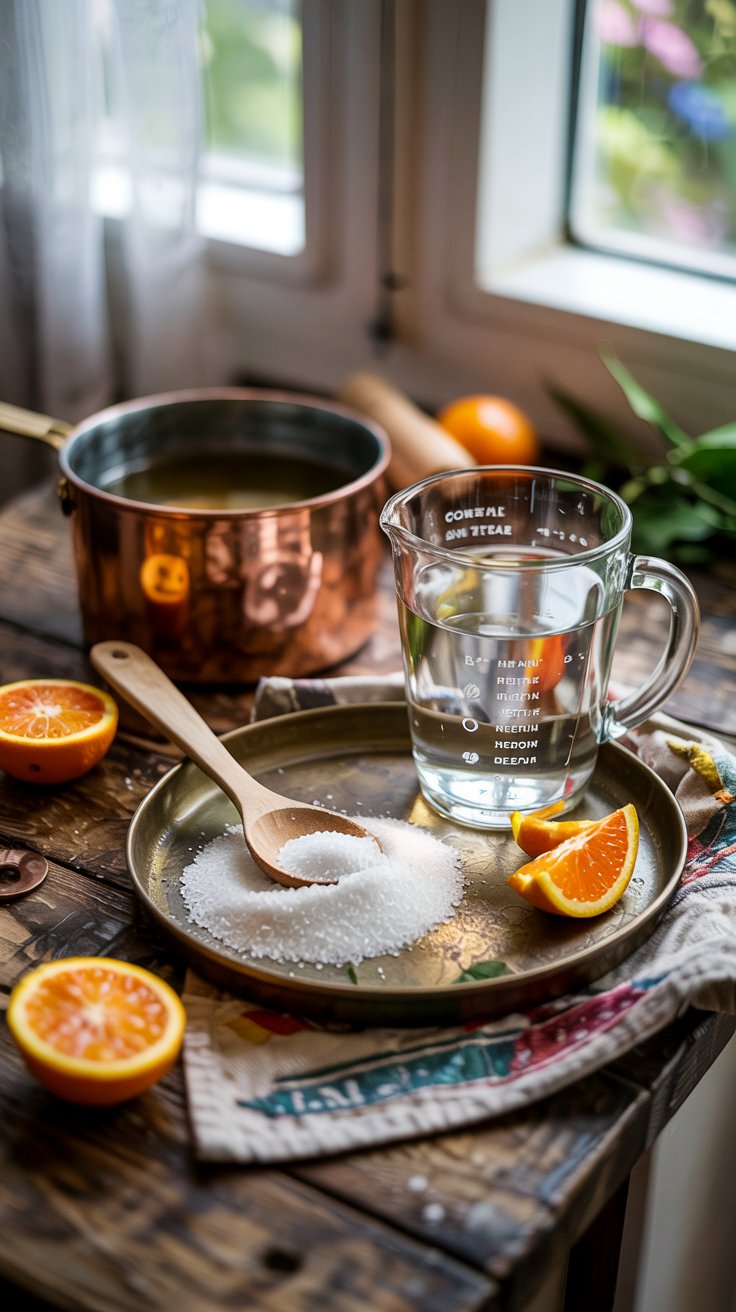
Making your own oriole nectar is simple, economical, and ensures the birds get the best nutrition without any harmful additives.
Simple Ingredients for a Perfect Mix
Want to attract beautiful orioles to your yard? The secret is in the nectar! Unlike hummingbird nectar, oriole nectar requires a slightly different sugar-to-water ratio. Here’s what you’ll need:
- Granulated sugar (regular table sugar) – 1 cup
- Water – 4 cups
- That’s it! No food coloring needed
The 1:4 ratio (1 part sugar to 4 parts water) perfectly mimics the natural nectar orioles find in fruits and flowers. This ratio is less concentrated than hummingbird nectar, which typically uses a 1:3 ratio.
Did you know? Orioles have a sweet tooth but don’t need nectar as concentrated as hummingbirds do. Their larger bodies and different metabolism mean they prefer a slightly more diluted solution.
Never use honey, artificial sweeteners, or brown sugar! These can be harmful to orioles and may cause fungal infections or other health problems.
Cooking Up the Sugar Solution
Ready to mix up some oriole-attracting goodness? Follow these simple steps:
- Measure 4 cups of water in a clean pot
- Add 1 cup of granulated sugar to the water
- Heat the mixture over medium heat until it reaches a light boil
- Stir occasionally until all sugar dissolves completely (about 1-2 minutes)
- Remove from heat and let cool to room temperature
The boiling process helps prevent fermentation and mold growth. Once cooled, your homemade nectar can be stored in the refrigerator for up to two weeks.
Pour your fresh nectar into clean feeders. Wash and refill feeders every 2-3 days in hot weather, or every 4-5 days in cooler weather. This prevents harmful bacteria growth that could make your oriole friends sick!
Why Orioles Can’t Resist This Nectar
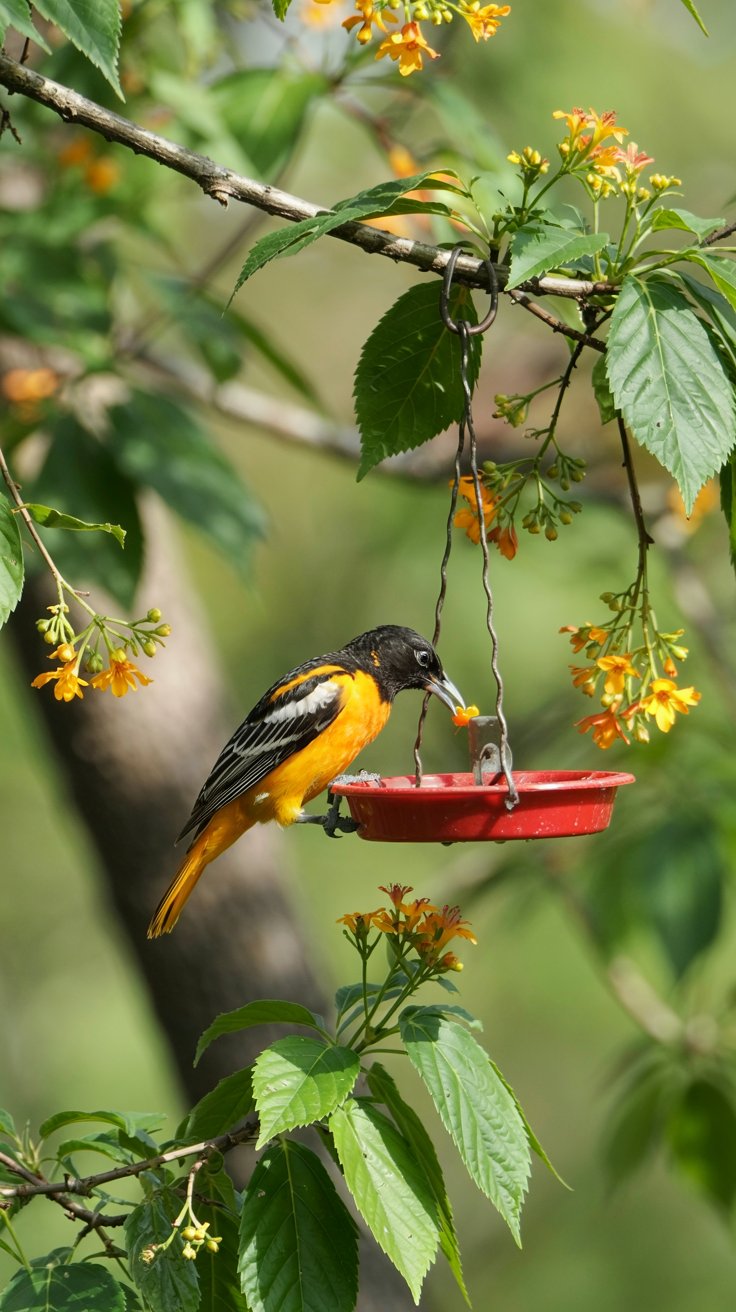
Orioles are naturally drawn to sweet homemade nectar that mimics their wild food sources. The perfect blend of sugar and water creates an irresistible treat that keeps these colorful birds coming back to your yard time and again.
The Nutritional Importance of Nectar
Orioles depend on nectar as a crucial energy source during migration and breeding seasons. These beautiful orange-and-black birds burn tremendous calories during their long journeys, making sugar-rich foods essential for their survival.
Did you know? A single oriole might visit your feeder up to 12 times per day when they’re actively feeding!
Nectar provides:
- Quick energy for daily activities
- Hydration combined with calories
- Supplemental nutrition when insects are scarce
While nectar alone isn’t a complete diet for orioles, it perfectly complements their natural foods like insects and fruit. Many oriole species also love jelly and orange halves, which provide similar sugary benefits with added nutrients.
Your homemade nectar serves as a reliable food source when natural options fluctuate with the seasons.
Tips and Tricks for Oriole Feeder Success
Attracting orioles to your yard takes more than just hanging any feeder. The right equipment, placement, and maintenance will significantly increase your chances of these beautiful orange birds becoming regular visitors.
Choosing the Right Oriole Feeder
When shopping for an oriole feeder, look for ones specifically designed for these birds. Unlike hummingbird feeders, oriole feeders typically feature:
- Orange components – This color naturally attracts orioles
- Wider perches – Orioles are larger than hummingbirds and need sturdier places to land
- Bee guards – These protective covers prevent insects from reaching the nectar
- Multiple feeding ports – Allows several birds to feed at once
The best feeders include a built-in funnel for easy filling without spills. Some models also offer spots for orange halves or grape jelly—favorite treats for orioles!
Want a budget option? You can make your own feeder using simple household items. Just ensure it has perches wide enough for orioles and is predominantly orange to catch their attention.
Strategic Feeder Placement
Where you hang your feeder matters tremendously for attracting orioles. These colorful birds have specific preferences:
- Hang feeders 15-20 feet high for maximum visibility
- Place in open areas where orioles can easily spot them when flying overhead
- Position near trees or tall shrubs (within 10-15 feet) to provide quick escape routes
- Keep feeders in partial shade to prevent nectar from fermenting quickly
Did you know orioles prefer feeding at the forest edge rather than deep in wooded areas? Try placing your feeder near the boundary of your yard for best results.
For multiple feeders, space them at least 10 feet apart to prevent territorial disputes. Some oriole species can be territorial around food sources!
Maintaining and Cleaning Your Feeder
Regular maintenance is crucial for both attracting orioles and keeping them healthy. Neglected feeders can spread disease!
Cleaning schedule:
- Rinse and refill with fresh nectar every 2-3 days in hot weather
- Complete cleaning with 10% bleach solution (1 part bleach to 9 parts water) weekly
- Scrub feeding ports and bee guards with a small brush to remove mold
- Always rinse thoroughly after cleaning
Don’t forget to check the feeder for cracks or damaged parts that might leak nectar. Sticky residue attracts ants and wasps, which will drive orioles away.
Want to prevent insects? Apply a thin layer of petroleum jelly around (not on) feeding ports. This creates a barrier ants can’t cross while keeping the nectar safe for birds.
Avoiding Common Homemade Nectar Mistakes
Making your own oriole nectar can save money and ensure your birds get the freshest food possible. However, several pitfalls can compromise both the safety and attractiveness of your homemade nectar.
The Sugar-Honey Debate
Should you use honey or sugar in your oriole nectar? This question confuses many bird enthusiasts, but the answer is clear: always use granulated sugar.
- Honey can contain spores that cause fungal infections in birds
- Honey ferments more quickly than sugar solutions
- Honey attracts more unwanted insects
Never use brown sugar, molasses, or artificial sweeteners as substitutes.
Preventing Fermentation and Mold
Have you ever noticed your nectar turning cloudy? That’s a clear sign it’s gone bad! Nectar spoilage happens faster than you might think, especially during warmer months.
To keep your nectar fresh:
- Clean feeders thoroughly between refills using a bottle brush (no soap residue!)
- Replace nectar every 2-3 days in hot weather, 3-5 days in cooler weather
- Store unused nectar in the refrigerator for up to two weeks
- Place feeders in partial shade to slow fermentation
Never add red food coloring or preservatives to extend shelf life. These additives can harm orioles. Instead, rely on the natural color of your feeder to attract birds. The orioles will find it!
Keeping the Bees and Wasps at Bay
Is your oriole feeder becoming a bee buffet? You’re not alone! Insects love sugar water just as much as birds do.
Try these effective strategies:
- Install bee guards on feeders when available
- Choose feeders with built-in moats that prevent insects from reaching the nectar
- Move the feeder slightly every few days (orioles will find it, insects might not)
- Wipe away drips immediately to avoid creating an insect attraction point
Many commercial feeders come with built-in bee guards or moats. If yours doesn’t, create a simple moat by hanging a cup of water above the feeder. Bees and wasps will drown if they try to access the nectar through the water.
Enticing Orioles Beyond Nectar
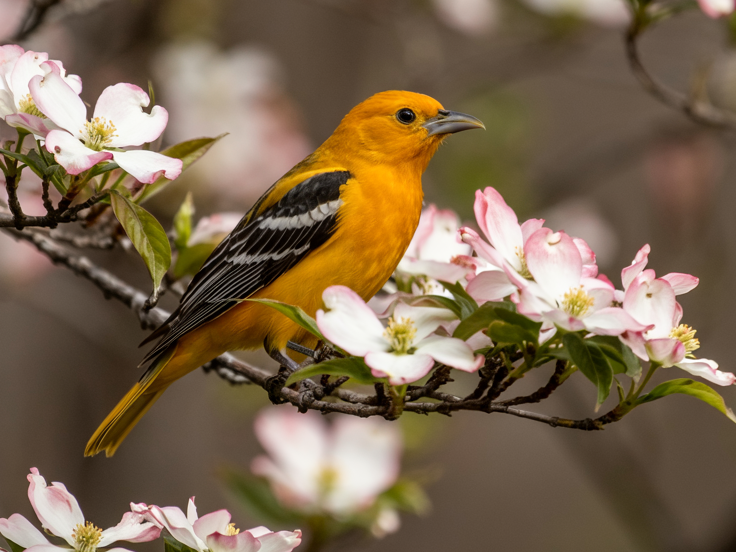
While nectar is a popular way to attract orioles, offering a variety of foods can keep these colorful birds coming back to your yard. Different food options provide complete nutrition and create a more attractive feeding station.
Supplementing Nectar with Orioles’ Favorite Treats
Orioles love fruit! Cut oranges in half and place them cut side up in your feeder to create an irresistible treat. These bright fruits serve as both food and visual attractants.
Grape jelly is perhaps the ultimate oriole magnet. Place about 1-2 tablespoons in a small dish or specialized jelly feeder. Remember to:
- Replace jelly every 1-2 days to keep it fresh
- Use commercial grape jelly (the birds prefer it!)
- Start with small amounts to reduce waste
Other fruits that orioles enjoy include:
- Apple slices
- Banana chunks
- Berries (especially blueberries)
The Role of Mealworms in Oriole Diets
Mealworms provide essential protein that orioles particularly need during nesting season. These nutritious treats help parent birds feed their growing chicks and maintain their own energy levels.
You can offer mealworms in three forms:
- Live mealworms (most attractive to birds)
- Dried mealworms (convenient and long-lasting)
- Soaked dried mealworms (rehydrated for easier eating)
Start with about 10-15 mealworms in a small dish with short sides. Place them near your nectar and jelly feeders where orioles will easily spot them.
A nesting pair of orioles might eat hundreds of insects daily. By offering mealworms, you’re helping them meet this huge protein demand! This supplement is especially valuable in early spring when natural insects might be scarce.
Key Takeaways
- Homemade oriole nectar requires just a 1:4 sugar-to-water ratio and should be placed in oriole-specific feeders with larger ports.
- Supplement your nectar offerings with halved oranges to create an irresistible feeding station that attracts orioles to your yard.
- Change nectar every 3-5 days and keep feeders clean to prevent mold and ensure orioles return throughout the season.
